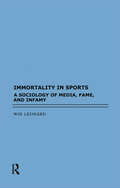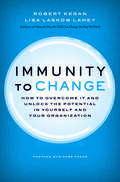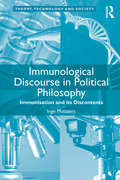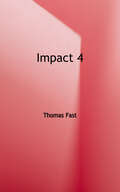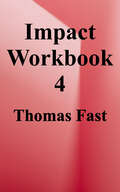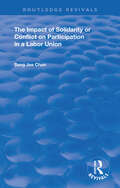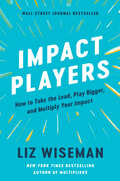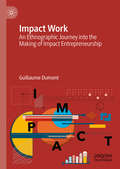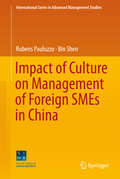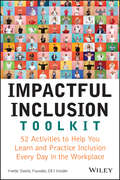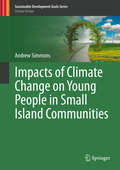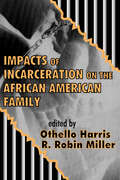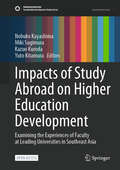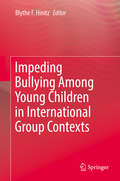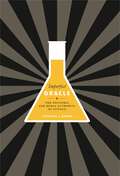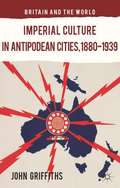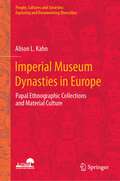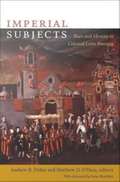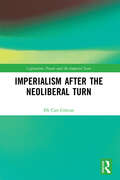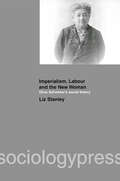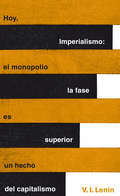- Table View
- List View
Immortality in Sports
by Wib LeonardSports have taken on tremendous importance in the world in which we live. Their social significance - economic, political, and personal - both nationally and internationally is unprecedented. What may not be so immediately obvious is the sociological nature of sports. Sport offers one of the most visible public arenas for understanding the role that 'immortality' plays in individual action, group dynamics, and with audiences and the media. Following a brief introduction to the sociology of sport, Leonard explores these dimensions of the sporting world through the idea of the 'post-self' - how individuals regard themselves and want to be remembered by the public. From the individual psyche to the global arena of sports, this book features vivid examples and quotations from star athletes, coaches, and the media, offering poignant insights into the sporting world and about individuals and society.
Immunity to Change
by Lisa Laskow Lahey Robert KeganA recent study showed that when doctors tell heart patients they will die if they don't change their habits, only one in seven will be able to follow through successfully. Desire and motivation aren't enough: even when it's literally a matter of life or death, the ability to change remains maddeningly elusive.Given that the status quo is so potent, how can we change ourselves and our organizations?In Immunity to Change, authors Robert Kegan and Lisa Lahey show how our individual beliefs--along with the collective mind-sets in our organizations--combine to create a natural but powerful immunity to change. By revealing how this mechanism holds us back, Kegan and Lahey give us the keys to unlock our potential and finally move forward. And by pinpointing and uprooting our own immunities to change, we can bring our organizations forward with us.This persuasive and practical book, filled with hands-on diagnostics and compelling case studies, delivers the tools you need to overcome the forces of inertia and transform your life and your work.
Immunological Discourse in Political Philosophy: Immunisation and its Discontents (Theory, Technology and Society)
by Inge MutsaersGiven the propensity of contemporary protection measures such as counterterrorism efforts and fierce protection strategies against viral threats, as well as physical and legal barriers against migration, a number of political philosophers, including Peter Sloterdijk and Roberto Esposito, have claimed that contemporary (political) culture can be characterised by a so-called ’immunisation paradigm’. This book critically examines the intricate entanglement between biological immunological notions and their political philosophical appropriation, whilst studying the ’immunisation response’ to recent viral threats, including the Swine Flu pandemic of 2009 and the lab-bred Avian flu threat of 2012, to analyse immunisation as a biopolitical strategy. Offering insights into to the polarising tendencies in contemporary political culture resulting from the appropriation of immunological concepts in political thought, the author also shows how political philosophers tend to build on purely defensive understandings of immunity. As such, Immunological Discourse in Political Philosophy constitutes a theoretically sophisticated critique of the ’semantic trap’ caused by the use of immunological concepts in political philosophy. Arguing for a more versatile and less defensive immunological repertoire, which allows for the development of alternative and less polarised forms of political debate, this book will appeal to scholars of political theory, sociology, philosophy and science and technology studies.
Impact 4
by Thomas FastImpact helps teenage learners to better understand themselves, each other, and the world they live in. By encouraging self-expression, global citizenship, and active participation, Impact motivates students to explore who they are and who they want to be, all while learning English!
Impact 4: Workbook
by Thomas FastImpact helps teenage learners better understand themselves, each other, and the world they live in. By encouraging self-expression, global citizenship, and active participation, impact motivates students to explore who they are and who they want to be - all while learning english the impact workbook contains activies that reinforce and consolidate the content of the student book, and includes listening, reading, writing, grammar, and vocabulary practice. The impact workbook includes - 10 pages of language practice, activities, and an additional reading for each unit. - now I can self-assessment sections, giving learners an opportunity to reflect on what they have learned and identify areas where they need additional practice. - review sections, featuring question types commonly found on standardized exams. - additional student-choice activities, providing opportunities for targeted skills practice. Impact helps teenage learners better understand themselves, each other, and the world they live in. By encouraging self-expression, global citizenship, and active participation, impact motivates students to explore who they are and who they want to be - all while learning english the impact workbook contains activies that reinforce and consolidate the content of the student book, and includes listening, reading, writing, grammar, and vocabulary practice. The impact workbook includes - 10 pages of language practice, activities, and an additional reading for each unit. - now I can self-assessment sections, giving learners an opportunity to reflect on what they have learned and identify areas where they need additional practice. - review sections, featuring question types commonly found on standardized exams. - additional student-choice activities, providing opportunities for targeted skills practice.
Impact Networks: Create Connection, Spark Collaboration, and Catalyze Systemic Change
by David EhrlichmanThis practical guide shows how to facilitate collaboration among diverse individuals and organizations to navigate complexity and create change in our interconnected world.The social and environmental challenges we face today are not only complex, they are also systemic and structural and have no obvious solutions. They require diverse combinations of people, organizations, and sectors to coordinate actions and work together even when the way forward is unclear. Even so, collaborative efforts often fail because they attempt to navigate complexity with traditional strategic plans, created by hierarchies that ignore the way people naturally connect.By embracing a living-systems approach to organizing, impact networks bring people together to build relationships across boundaries; leverage the existing work, skills, and motivations of the group; and make progress amid unpredictable and ever-changing conditions. As a powerful and flexible organizing system that can span regions, organizations, and silos of all kinds, impact networks underlie some of the most impressive and large-scale efforts to create change across the globe. David Ehrlichman draws on his experience as a network builder; interviews with dozens of network leaders; and insights from the fields of network science, community building, and systems thinking to provide a clear process for creating and developing impact networks. Given the increasing complexity of our society and the issues we face, our ability to form, grow, and work through networks has never been more essential.
Impact Of Solidarity
by Bang Jee ChunFirst published in 1997. Members’ participation in a labor union, as in any other social movement organization, occurs in the context of their multiple organizational involvements. Union members come to the union with membership in several other organizations. Do their multiple organizational involvements have any consequences for how active they are in a union? Do union members’ multiple organizational involvements promote or constrain their participation in a union? Under what conditions do organizational involvements influence the degree of union participation? Including a review of past literature on this area, this study aims to address these questions.
Impact Players: How to Take the Lead, Play Bigger, and Multiply Your Impact
by Liz WisemanWhy do some people break through and make an impact while others get stuck going through the motions?In every organization there are Impact Players—those indispensable colleagues who can be counted on in critical situations and who consistently receive high-profile assignments and new opportunities. Whether they are on center stage or behind the scenes, managers know who these top players are, understand their worth, and want more of them on their team. While their impact is obvious, it’s not always clear what actually makes these professionals different from their peers.In Impact Players, New York Times bestselling author and researcher Liz Wiseman reveals the secrets of these stellar professionals who play the game at a higher level. Drawing on insights from leaders at top companies, Wiseman explains what the most influential players are doing differently, how small and seemingly insignificant differences in how we think and act can make an enormous impact, and why—with a little coaching—this mindset is available to everyone who wants to contribute at their highest level. Based on a study of 170 top contributors, Wiseman identifies the mindsets that prevent otherwise smart, capable people from contributing to their full potential and the five practices that differentiate Impact Players:While others do their job, Impact Players figure out the real job to be done. While others wait for direction, Impact Players step up and lead.While others escalate problems, Impact Players move things across the finish line.While others attempt to minimize change, Impact Players are learning and adapting to change. While others add to the load, the Impact Players make heavy demands feel lighter.Wiseman makes clear that these practices—and the right mindset—can help any employee contribute at their fullest and shows leaders how they can raise the level of play for everyone on the team. Impact Players is your playbook for the new workplace.
Impact Work: An Ethnographic Journey into the Making of Impact Entrepreneurship
by Guillaume DumontThis book provides a critical, ethnographically grounded examination of the hype surrounding the idea of impact by investigating the work of those attempting to create innovative social ventures. Through in-depth immersion in the day-to-day running of a social impact accelerator, Guillaume Dumont reveals the intricate, behind-the-scenes socialization through which entrepreneurs learn the ropes of impact entrepreneurship and sheds light on the roles of some of the key players of this unique social world. The book challenges the view that impact is a given property of a venture resulting from an intrinsic desire to change the world embodied by gifted and compassionate entrepreneurs. Instead, Dumont argues that impact emerges iteratively from a process of social engagement and negotiation among entrepreneurs, investors, corporate executives, and mentors as they collaborate in the mundane processes of its production, what he calls “Impact work.” This book, therefore, is about impact in the making. It is a story of hope and collaboration unveiling the social and cultural challenges and contradictions faced by those attempting to create alternative organizations addressing social and commercial goals.
Impact of Culture on Management of Foreign SMEs in China (International Series in Advanced Management Studies)
by Bin Shen Rubens PauluzzoThis book describes how a deeper knowledge and understanding of cultural differences represents a meaningful and useful tool for management of companies, and in particular SMEs, in the People’s Republic of China. After introductory chapters on the internationalization of SMEs and the role played by management in this process, the authors explore the implications of academic discourses on culture and its dimensions for company management. The influence of Chinese cultural roots and the country’s current cultural environment on management is then examined, with provision of guidance on response to the identified challenges. A key feature of the book is the presentation of important recent fieldwork in the main economic regions of China. This research further clarifies how business culture and cultural differences impact on company activities in China and casts light on various aspects of the adaptive capability of SMEs within the country, highlighting the value of cultural awareness and intelligence. The book will be of interest to academics and practitioners alike.
Impactful Inclusion Toolkit: 52 Activities to Help You Learn and Practice Inclusion Every Day in the Workplace
by Yvette SteelePractical, hands-on strategies to increase inclusion, diversity, and equity in your workplace In Impactful Inclusion Toolkit: 52 Activities to Help You Learn and Practice Inclusion Every Day in the Workplace, accomplished diversity, equity, and inclusion (DEI) strategist and leader Yvette Steele delivers a collection of practical and hands-on exercises that encourage and promote inclusion in the workplace. The exercises emphasize the development of key inclusive behaviors, including self-knowledge, connecting with others, creating new habits, and experiencing other cultures. In the book, you&’ll find: 52 behaviors to practice during the year that will empower you to be more inclusive in the real world Concrete instructions regarding how to become more inclusive, rather than just high-level information about inclusivity generally Actionable strategies to help drive change in your organization and manage the discomfort that sometimes exists around DEI issues An effective and practical resource for anyone who wants to be more inclusive. Frontline and knowledge workers can empower themselves to drive change with weekly activities and resources. DEI and HR professionals, company founders, owners, managers, and other business leaders can better support staff on their inclusion journey. The Impactful Inclusion Toolkit is an essential addition to DEI strategies of any organization whether they are active or aspire to be more inclusive.
Impacts of Climate Change on Young People in Small Island Communities (Sustainable Development Goals Series)
by Andrew SimmonsThis book presents a comprehensive overview of the history, definition, causes, effects, impacts and implications of climate change on young people globally, with a focus on Small Island Communities (SIDS) in particular. The text highlights the key problems associated with the impact of climate change on young people in SIDS, specifically its effects on socio-economic development and livelihoods, and explores the need for the development of a new conceptual framework to deal with building the resilience of the adaptive capacity of youth in SIDS. The book analyzes the strengths and weaknesses of the emerging phenomenon of Global Youth Climate Change Movements/Actions, and examines the management/governance challenges associated with the Movement in terms of its operational mechanism, mobilization strategies and its use of social media/technology to mobilize mass action. The text concludes with a recommendation for further research in this area as a way to understand how the Movement functions and its mechanism for implementation of future research.
Impacts of Incarceration on the African American Family
by R. Robin MillerThe criminal justice system has driven a wedge between black men and their children. African American men are involved in the criminal justice system, whether through incarceration, probation, or parole, at near epidemic levels. At the same time, the criminal justice system has made little or no institutional efforts to maintain or support continuing relationships between these men and their families. Consequently, African American families are harmed by this in countless ways, from the psychological, physical, and material suffering experienced by the men themselves, to losses felt by their mates, children, and extended family members.The volume opens with an introduction and brief review by R. Robin Miller, Sandra Lee Browning, and Lisa M. Spruance, outlining the impacts of incarceration on the African American family. Brad Tripp, explores changes in family relationships and the identity of incarcerated African American fathers. Mary Balthazar and Lula King discuss the loss of the protective effect of marital and nonmarital relationships and its impact on incarcerated African American men, and the implications for African American men and those who work with them in the helping professions. Theresa Clark explores the relationship between visits by family and friends and the nature of inmate behavior. In a research note, Olga Grinstead, Bonnie Faigeles, Carrie Bancroft, and Barry Zack investigate the actual costs families incur to maintain contact with family members, be it emotional, social, or financial. Patricia E. O'Connor uses data from sociolinguistic interviews of male inmates from a maximum security prison to study how some of these men manage to continue to fulfill the fatherhood role long-distance. In a concluding chapter, Sandra Lee Browning, Robin Miller, and Lisa Spruance focus on actions of the criminal justice system that undermine the black family, on reasons that black male inmate fathers are studied so rarely, and discuss the role restorative justice may play.This insightful volume fills a void in the literature on the role of African American men in the functioning of families. It will be of interest to students of African American studies, social workers, and policy makers.
Impacts of Racism on White Americans In the Age of Trump
by Benjamin P. Bowser Duke W. AustinIn this third iteration of the classic work The Impacts of Racism on White Americans (1981, 1996), a new generation of scholars make the case that racism often negatively affects Whites themselves, especially during the Trump era. In 1981, Impacts introduced an alternative understanding of racism, arguing that it went beyond white-black and/or inter-race relations. Instead, the book proposed that the problem of race in the U.S. is fundamentally one of white identity and culture and that racism has substantial negative effects on White Americans. This volume advances these propositions through three key areas: (1) Trump-era cultural and institutional racism, bolstered by the use of historical notions of racial hierarchy; (2) institutional and interpersonal racism, which in turn drive individual racist behaviors; and finally, (3) racism’s interactional sequences and how they impact anti-racism efforts. As each chapter author explores an iteration of these racisms, they also explore how racist attitudes produce disadvantage among White Americans.
Impacts of Study Abroad on Higher Education Development: Examining the Experiences of Faculty at Leading Universities in Southeast Asia (Sustainable Development Goals Series)
by Yuto Kitamura Kazuo Kuroda Nobuko Kayashima Miki SugimuraThis open-access book is an exceptional contribution to the burgeoning fields of higher education development and higher education internationalization as it empirically examines the impact of the study abroad experiences of faculty members on individual and institutional development. The research and its outcomes presented here utilize results from a large-scale survey and interviews of faculty at ten leading universities in Malaysia, Indonesia, Vietnam, and Cambodia. The analyses show that the study abroad experiences of faculty members impact not only improvements in research quality and development of educational programs but also serve as the foundation for international activities at the university, crucially important in today’s higher education landscape. On the other hand, the research reveals the rapid development of higher education at the local and regional levels including the development of graduate programs for faculty training in the home country leading to increasing rates of study abroad within Southeast Asia. Through the analyses presented, this book offers a new understanding of higher education development and internationalization in Southeast Asia by examining the impact of study abroad on the academic profession, higher education institutions and the higher education sector.
Impeding Bullying Among Young Children in International Group Contexts
by Blythe F. HinitzThis volume showcases proven approaches and strategies to diminish the world-wide problem of bullying, and constitutes an overview of an international and multilingual (English, Spanish and Bahasa Indonesian) approach to anti-bullying, harassment, intimidation and teasing (HIBT) education. Chapter topics include the genesis of The Anti-Bullying and Teasing Book in response to a need for program materials for younger children, the tri-lingual implementation of the program in two countries, the infusion of the program into the ongoing curriculum and practice of two schools, the museum as an alternative setting for creative practice, and adaptations of the program based on culture and language. Impeding Bullying Among Young Children in International Group Contexts is a critical resource for educators, administrators, and policy-makers seeking to implement better strategy and policy to combat bullying.
Imperfect Oracle: The Epistemic and Moral Authority of Science (G - Reference, Information and Interdisciplinary Subjects)
by Theodore L. BrownScience and its offshoot, technology, enter into the very fabric of our society in so many ways that we cannot imagine life without them. We are surrounded by crises and debates over climate change, stem-cell research, AIDS, evolutionary theory and “intelligent design,” the use of DNA in solving crimes, and many other issues. Society is virtually forced to follow our natural tendency, which is to give great weight to the opinions of scientific experts. How is it that these experts have come to acquire such authority, and just how far does their authority reach? Does specialized knowledge entitle scientists to moral authority as well? How does scientific authority actually function in our society, and what are the countervailing social forces (including those deriving from law, politics, and religion) with which it has to contend? Theodore Brown seeks to answer such questions in this magisterial work of synthesis about the role of science in society. In Part I, he elucidates the concept of authority and its relation to autonomy, and then traces the historical growth of scientific authority and its place in contemporary American society. In Part II, he analyzes how scientific authority plays out in relation to other social domains, such as law, religion, government, and the public sphere.
Imperial Culture in Antipodean Cities, 1880–1939
by John GriffithsDrawing on a wealth of primary and secondary sources, this book explores how far imperial culture penetrated antipodean city institutions. It argues that far from imperial saturation, the city 'Down Under' was remarkably untouched by the Empire.
Imperial Museum Dynasties in Europe: Papal Ethnographic Collections and Material Culture (People, Cultures and Societies: Exploring and Documenting Diversities)
by Alison L. KahnThis book reveals the history of the Vatican’s ethnographic collections by exploring the imperial, scientific, technological, and religious agendas behind its collecting and curating practices in the early twentieth century. It focuses on two principal contributors: the academic, priest, and ‘Pope’s Curator’, Father Wilhelm Schmidt, SVD, and the missionary and linguist, Father Franz Kirschbaum, SVD. Their narratives are embedded in a unique set of comparisons between the ‘liberal humanist ideals’ that underpinned the 1851 Great Exhibition, mid-nineteenth-century German museology, and the 1925 Pontifical Missionary Exhibition. It relates to the period of high colonialism and rampant missionary activity worldwide. It unravels the complicated political and ideological stance taken by the Catholic Church and its place within the science/religion debates of its time. Establishing an essential link between the secular and catholic practices of collecting and curating ethnographic objects from non-Western traditions, the author proposes a broader framework for post-colonial approaches to scholarly studies of ethnographic collections, including those of the Catholic Church. This book appeals to students and scholars of anthropology, museum studies, history, art history, religion, politics, and cultural studies.
Imperial Policing: Weaponized Data in Carceral Chicago
by Andy Clarno Janaé Bonsu-Love Enrique Alvear Moreno Lydia Dana Michael De Muñiz Haley Volpintesta Ilā RavichandranExposing the carceral webs and weaponized data that shape Chicago&’s police wars Chicago is a city with extreme concentrations of racialized poverty and inequity, one that relies on an extensive network of repressive agencies to police the poor and suppress struggles for social justice. Imperial Policing examines the role of local law enforcement, federal immigration authorities, and national security agencies in upholding the city&’s highly unequal social order. Collaboratively authored by the Policing in Chicago Research Group, Imperial Policing was developed in dialogue with movements on the front lines of struggles against racist policing in Black, Latinx, and Arab/Muslim communities. It analyzes the connections between three police &“wars&”—on crime, terror, and immigrants—focusing on the weaponization of data and the coordination between local and national agencies to suppress communities of color and undermine social movements. Topics include high-tech, data-based tools of policing; the racialized archetypes that ground the police wars; the manufacturing of criminals and terrorists; the subversion of sanctuary city protections; and abolitionist responses to policing, such as the Erase the Database campaign. Police networks and infrastructure are notoriously impenetrable to community members and scholars, making Imperial Policing a rare, vital example of scholars working directly with community organizations to map police networks and intervene in policing practices. Engaging in a methodology designed to provide support for transformative justice organizations, the Policing in Chicago Research Group offers a critical perspective on the abolition of imperial policing, both in Chicago and around the globe.
Imperial Sceptics
by Gregory ClaeysImperial Sceptics provides a highly original analysis of the emergence of opposition to the British Empire from 1850-1920. Departing from existing accounts, which have focused upon the Boer War and the writings of John Hobson, Gregory Claeys proposes a new chronology for the contours of resistance to imperial expansion. Claeys locates the impetus for such opposition in the late 1850s with the British followers of Auguste Comte. Tracing critical strands of anti-imperial thought through to the First World War, Claeys then scrutinises the full spectrum of socialist writings from the early 1880s onwards, revealing a fundamental division over whether a new conception of 'socialist imperialism' could appeal to the electorate and satisfy economic demands. Based upon extensive archival research, and utilising rare printed sources, Imperial Sceptics will prove a major contribution to our understanding of nineteenth-century political thought, shedding new light on theories of nationalism, patriotism, the state and religion.
Imperial Subjects: Race and Identity in Colonial Latin America
by Andrew B. Fisher Matthew D. O'HaraIn colonial Latin America, social identity did not correlate neatly with fixed categories of race and ethnicity. As Imperial Subjects demonstrates, from the early years of Spanish and Portuguese rule, understandings of race and ethnicity were fluid. In this collection, historians offer nuanced interpretations of identity as they investigate how Iberian settlers, African slaves, Native Americans, and their multi-ethnic progeny understood who they were as individuals, as members of various communities, and as imperial subjects. The contributors' explorations of the relationship between colonial ideologies of difference and the identities historical actors presented span the entire colonial period and beyond: from early contact to the legacy of colonial identities in the new republics of the nineteenth century. The volume includes essays on the major colonial centers of Mexico, Peru, and Brazil, as well as the Caribbean basin and the imperial borderlands. Whether analyzing cases in which the Inquisition found that the individuals before it were "legally" Indians and thus exempt from prosecution, or considering late-eighteenth- and early-nineteenth-century petitions for declarations of whiteness that entitled the mixed-race recipients to the legal and social benefits enjoyed by whites, the book's contributors approach the question of identity by examining interactions between imperial subjects and colonial institutions. Colonial mandates, rulings, and legislation worked in conjunction with the exercise and negotiation of power between individual officials and an array of social actors engaged in countless brief interactions. Identities emerged out of the interplay between internalized understandings of self and group association and externalized social norms and categories. Contributors. Karen D. Caplan, R. Douglas Cope, Mariana L. R. Dantas, Mara Elena Daz, Andrew B. Fisher, Jane Mangan, Jeremy Ravi Mumford, Matthew D. O'Hara, Cynthia Radding, Sergio Serulnikov, Irene Silverblatt, David Tavrez, Ann Twinam
Imperialism after the Neoliberal Turn (Capitalism, Power and the Imperial State)
by Efe Can GürcanThis book explores how imperialism has been evolving in the neoliberal era, with the aim of providing a systematic and integrative understanding of the inner dynamics and vulnerabilities of the contemporary imperialist system. Asking how it has been possible to sustain an imperialist system that fails to address the problems of unemployment, declining standards of living and globalizing conflicts, the author draws upon theoretical and empirical contributions from the current literature to further recent efforts at re-conceptualizing imperialism under the conditions of neoliberal globalization and advances a critique of the school of transnationalism in global political economy. The author puts forward that contemporary imperialism rests on a triangular structure composed of (a) economic imperialism, which is driven by a neoliberal logic of maximizing monopoly profits at massive societal costs; (b) military imperialism, which is shaped by the neoliberal transformation of the US military-industrial complex with the rise of private armies, the globalization of narcocapitalism, and the weaponization of Islamist terrorism and ethno-religious divides; and (c) cultural imperialism, which is led by the media- and nonprofit-corporate complexes, having weaponized the media and civil society in manufacturing popular consent. The book’s arguments are also extended to the current challenges of imperialism embodied in the rise of the BRICS, post-hegemonic forms of regional cooperation, and global popular resistance. As such, it will appeal to scholars of politics and sociology with interests in globalization, imperialism, capitalism, and global power.
Imperialism, Labour and the New Woman: Olive Schreiner's Social Theory
by Liz StanleyOlive Schreiner (1855-1920) was the best-known feminist theorist and writer of her time. Her writings spanned a number of conventionally separate genres (including the novel, short story, allegory, political essay, polemic and theoretical treatise), which she crafted to produce a highly distinctive feminist and analytical 'voice'. A feminist who was contemporaneously an internationally-renowned social commentator, Schreiner's developing political analysis was - and still is - highly original. She developed a materially-based socialist and feminist analysis of 'labour' which led her to theorise social and economic change, divisions of labour in society and between women and men, capitalism and imperialism, around innovative ideas about how -- and by whom -- economic and social value was produced. She combined with this a keen attention to inter-personal relations, between women as literally or politically sisters, between 'respectable' and sexually outcast women, between feminist women and the 'New Men', and within the family. Distinctively, Schreiner's writings on economic and political life in South Africa criticised the policies and practice of Rhodes in the Cape Colony and British imperialism in southern Africa more widely. She opposed the South African War of 1899-1902, promoted federation rather than union as the form the South African state should take and insisted on equal political rights for all. Schreiner steadfastly opposed the development of apartheid segregationist policies and provided a radical analysis of the relationship between 'race' and capital. Imperialism, Labour and the New Woman is based on primary archive research, making particular use of Schreiner's unpublished letters and other major manuscript sources to provide a major reconceptualisation of the scope and importance of her writings and innovative and experimental ideas about genre and form. It offers a major rethinking of Schreiner's political writings on South Africa, and it emphasises the distinctiveness of Schreiner's contribution as the major feminist theorist of her age and that which followed. The book will appeal particularly to readers interested in the development of social theory, in influential feminist ideas and writing of the fin de sicle period, in the contemporary critique of capitalism and imperialism, and in 'the age of imperialism' in Southern Africa, as well as to Women's Studies scholars across the academic disciplines.
Imperialismo: la fase superior del capitalismo (Serie Great Ideas #Volumen 20)
by V. I. LeninIdeas que han cambiado el mundo. A lo largo de la historia, algunos libros han cambiado el mundo. Han transformado la manera en que nos vemos a nosotros mismos y a los demás. Han inspirado el debate, la discordia, la guerra y la revolución. Han iluminado, indignado, provocado y consolado. Han enriquecido vidas, y también las han destruido. Taurus publica las obras de los grandes pensadores, pioneros, radicales y visionarios cuyas ideas sacudieron la civilización y nos impulsaron a ser quienes somos. Lenin elaboró este texto marxista enormemente influyente para explicar en detalle los defectos inevitables y el poder destructivo del capitalismo, que conduciría ineludiblemente al imperialismo, a los monopolios y al colonialismo. Profetizó que los países del Tercer Mundo usados meramente como mano de obra capitalista no tendrían más opción que unirse a la revolución comunista en Rusia. Comentarios sobre lacolección Great Ideas:«De veras que la edición es primorosa y pocas veces contenido y continente pueden encontrarse mejor ensamblados y unidos. ¡Qué portadas! Para enmarcar. [...] Ante las Great Ideas, solo cabe quitarse el sombrero. ¡Chapeau!»ABC «Taurus propone un doble envite con este lanzamiento. Por un lado aumenta su compromiso con el ensayo; por otro, recupera el gusto por la estética. A los volúmenes se les ha proporcionado una portada delicada y cuidada (copian el original británico) que invita a la lectura.»La Razón «Un fenómeno editorial.»The Guardian «Aparte de los contenidos, en general muy bien elegidos, son tan bonitos que si los ven seguro que cae alguno.»El País «Ideas revolucionarias, crónicas de exploraciones, pensamientos radicales... vuelven a la vida en estas cuidadísimas ediciones, muy atractivas para nuevos lectores.»Mujer Hoy «Grandes ideas bien envueltas. De Cicerón a Darwin, esta colección entra por los ojos.»Rolling Stone «Original y bella iniciativa la emprendida por Taurus con su colección Great Ideas.»Cambio 16 «Hay libros inmortales, libros únicos que contienen pensamientos y reflexiones capaces de cambiar el mundo, tesoros en miniatura reagrupados en la colección Great ideas.»Diario de León
